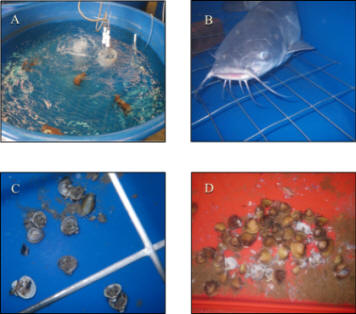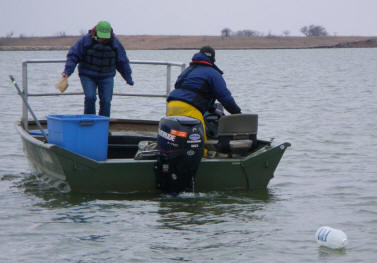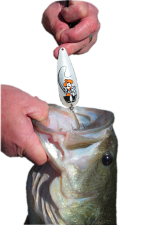Blue catfish gut passage as a vector for dispersal of invasive bivalves
Project personnel: Michael Gatlin, Jim Long, & Dan Shoup
Gatlin, M.R.**, Shoup, D.E., and Long J.M. Invasive zebra mussels (Driessena polymorpha) and Asian clams (Corbicula fluminea) survive gut passage of migratory fish species: implications for dispersal. Biological Invasions. 15:1195-1200.

The introduction and spread of invasive species is of great concern to natural resource managers in the United States. State and federal agencies allocate large sums of money annually to control invasive species in North America’s water bodies. To be effective, managers must be aware of the multitude of dispersal methods used by these organisms. We investigated the potential for survival of zebra mussel (Dreissena polymorpha) and Asian clam (Corbicula fluminea) through the gut of a migrating fish (blue catfish, Ictalurus furcatus) as a dispersal mechanism for these invasive bivalves. Blue catfish are particularly likely to facilitate the spread of these bivalves because they readily forage on mussels and lack molariform pharyngeal teeth to crush ingested shells.

Blue catfish sampled from Sooner Lake, Oklahoma, were transported to a wet laboratory and placed into individual tanks. After 48 hours, fish were removed and all fecal material was collected and inspected for live mussels. Most fish had zebra mussels and Corbicula in their feces. Mussels were found in fish feces from 80% of the 10 sampling events. We found that 0-64% of the zebra mussels recovered per fish (number of zebra mussels per fish ranged from 0-171) and 0-23% of the Corbicula recovered per fish (number of Corbicula per fish ranged from 0-280) were alive. Survival was highest during colder times of the year. Smaller zebra mussels were more likely to survive gut passage than larger zebra mussels. Mussel survival estimates are likely conservative because empty shells may have been consumed during their non-selective foraging (i.e. violating our assumption that all recovered mussels were alive when ingested). As a result, we believe that survival through the gut of blue catfish is an effective dispersal method for these invasive bivalve species.

Graphs of the logistic equation relating percent survival of Asian clam and zebra mussel that passed through the guts of blue catfish in Sooner Lake, Oklahoma to water temperature and shell length.


